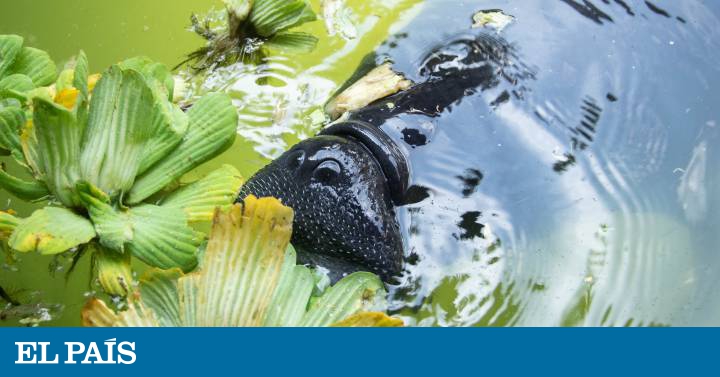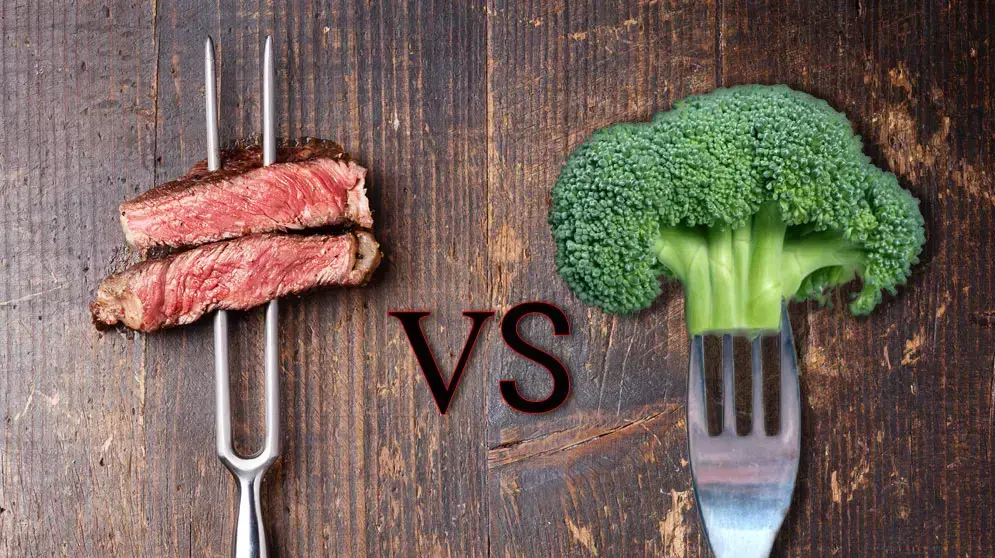- So this isn't a zoo?
- No, this is a rescue center. We can free animals, zoos almost never.
Cristian Vélez, environmental engineer, answers the question forcefully. And the very atmosphere of the site confirms that difference. There are no sweet cotton vendors here, no photographers everywhere, much less people looking for their man-animal selfie. Furthermore, the latter is clearly prohibited.
MORE INFORMATION
PHOTO GALLERY This is not a zoo- The boundary between animals and people
- The salvation of the tiger they used as a pet and then abandoned
- Species trafficking has a new victim: donkeys
What yes there are cages with some primates, birds or felines; pools with alligators and turtles, of various species; and photos with signs that explain the supreme objective of the Amazon Rescue Center (CREA), in Loreto (Peru): rescue, rehabilitate and eventually release species of wildlife that inhabit the Amazon ecosystem. All submerged in a forest.
The drama of Miki and Maqui
In a cage, a tigrillo ( Leopardus pardalis ) rests, apparently relaxed. The beautiful feline is medium in size and yellowish in color with black spots. It weighs more than 10 kilos and is very adaptable to various ecosystems (forests, swamps, grasslands). They call this Miki and he is here because the Ecological Police confiscated him in a jungle community and took him to CREA. At first impression, it seems cruel to see him locked up, but there is no alternative. "Unfortunately, it cannot return to nature, because it is a specimen that has been with humans since it was a baby," says Vélez.
Someone found him in the jungle, very small, turned him into a pet and, of course, he did not learn to hunt. A dedicated mother should have taught her to catch monkeys, birds, small lizards, or turtle eggs. Since he's grown up and became dependent, he will no longer learn it if he quits and could even take fatal risks. It has a limited destination.
Something similar happens with Maqui, a monkey of the maquisapa species ( Ateles belzebuth ), which slides down gracefully in another cage thanks to its long arms and prehensile tail. They caught him when he was a kid, he grew up depending on the human being and, like Miki, he probably won't be able to return. "I do not know if that animal has the ability to vocalize with another maquisapa. If I release it alone, any group will reject it ”, explains Violeta Barrera, the CREA veterinarian.
Something like this already happened, in mid-2019, with a pygmy marmoset ( Cebuella pygmaea ) that seemed ready to be released and leave with a family of its kind in a neighboring forest. About 10 free individuals had approached him attracted by, say, Marmoset language, so they opened the door of the cage for the exchange to intensify. The monkey suddenly disappeared, presuming that he was already making his life. But after five days he returned full of bruises on his body. "This is an adult male and probably the others in the family did not accept it well," says Barrera. It is unknown if he will be able to try again. Maybe not and, like Miki and Maqui, he stays here forever. Because that may be the future of an animal that the human species decided to turn into an object.
Pets that are not
The fundamental maxim of CREA staff could be summarized as follows: do not disturb wild animals, do not mistreat them, do not forcefully remove them from their ecosystems, do not forcibly make them pets
The fundamental maxim of CREA staff could be summarized as follows: do not disturb wild animals, do not mistreat them, do not forcefully remove them from their ecosystems of origin, do not make them pets by force. Nor should they be taught to speak if, for example, it is a species of parrot (the parrot family) that is not domestic.
In this refuge there is a specimen of the Amazonian Farin Parrot ( Amazona farinosa ). It is beautiful, of a regular size, of a deep green color. It has the typical appearance of those parrots that live captive or even appear in cartoon films. But it turns out that it is globally threatened. It is not the pet we dream of.
That is what the Convention on International Trade in Endangered Species of Wild Fauna and Flora (CITES) says, which also alerts on the need to take measures to protect it. However, Barrera says that, sometimes, when a visitor enters this enclosure, he sees this parrot and says: "Hello, hello parrot, how are you!"
Exactly what not to do. “They have an incredible ability in their larynx to reproduce sounds. They repeat 'hello', but do not know what they say. This decreases your chances of communicating normally with others of your kind. If we release him in that state, the people who hear him 'speak' will want to capture him, ”explains the expert. I should have known until Disney.
There is a very complex code for dealing with rescued animals. Primates and birds often become dependent easily. Reptiles, on the other hand, are more independent and are generally better candidates for release. They are animals that do not allow themselves to be cuddled, like other species, and also do not live in groups and look for their food in smaller spaces.
Although not all birds are tame. Here live a red and blue macaw ( Ara macao ) and a blue and yellow macaw ( Ara ararauna) . The first is called Wings because it lacks the right wing. You will never be able to return to the wild because of your disability. The other is rather aggressive, flies well, leaves and returns. "He does have a chance to go to the forest," says Barrera.
Primates and birds often become easily dependent
The monkeys can be released if they find a family that takes them in, not as it happened with the beaten marmoset. But if they arrive very malnourished - as happened with Pocahontas, a female specimen of the yellow-tailed woolly monkey ( Oreonax flavicauda ) - the veterinarian should treat them. That implies, in some cases, giving them vitamins or medications, with which they will develop better antibodies. At the same time, they can acquire new bacteria in the refuge that later, when released, would affect natural populations. "Therefore, on the issue of liberation, great care must be taken," emphasizes Vélez. Today it has even been seen that they could also transmit viruses to humans, as seems to have happened with the coronavirus, which would have come from a wild animal.
Manatee's deed
All this odyssey in search of rescuing wild species began on a memorable day in 2007. Javier Velásquez, a biologist from Iquitos, was visiting an office of the Regional Production Directorate (Direpro), when he saw an Amazonian manatee calf ( Trichechus inunguis ) that was deposited in a trough.
He had been seized in Iquitos himself, but when he asked if there was a protocol to help him, they told him that it simply did not exist. He asked to take him away, but the authorities did not agree because he was not an institution, but a natural person. A few days later he learned that the manatee baby died hopelessly, perhaps from starvation.
Desolate, Velásquez formed — after a few months and with three friends — the Association for the Conservation of Amazon Biodiversity. By then, 15 manatees had been counted dead in similar conditions. In November, when he found another manatee in Direpro, he asked to take it away and placed it in a tank that was in his uncle's house.
They gave him milk formulas for humans, and at the same time they asked for help from the Puerto Rico Manatee Rescue Center, the Research Institute of the Peruvian Amazon (IIAP) and the Dallas World Aquarium Zoo. With such supports, in 2008, CREA was born, which even managed to get a special milk called Milk Matrix 33/40.
Thanks to this feat, today we see Alegría, a manatee female about four years old, in healthy conditions and swimming in a pool. She looks bulky, but she is barely a teenager close to weaning. In this period of childhood-adolescence, these animals are extremely vulnerable and that is when they are usually captured.
It usually happens that some Amazonian fishermen find them in their net. The animal seems curious to them, they take it away and have it as a pet. They give it water lettuce, gramalote or other aquatic plants, which are the natural food of the manatee. But they don't know that until about three years old, a manatee calf cannot eat those plants. "It is as if you gave a baby a hamburger," says Velásquez. On one occasion, he recalls, they found a small manatee floating in a pool. Those who had it said that he was happy, like sunbathing, but in reality he was in a severe state of malnutrition. So it floated, even though they normally don't.
Release and protection
"In nature you will not see them floating, you will only see that they take out their noses to breathe," continues the founder of CREA. Velásquez also saw, in 2016, a manatee calf that was in a cachexic state (extreme malnutrition), because it had spent weeks without eating, only feeding on its own fat, which is abundant.
"These animals are impossible to save. As much as they desperately accept the bottle, they already have a totally depressed immune system and organs that are no longer working, ”he adds with some sadness. He and his team have seen 13 manatees die under those conditions. Part of the tragedy originates from ignorance.
Unlike Caribbean manatees, Amazonians live in dark, depleted bodies of water. People find out that they exist when they appear in a network, or when they show their noses. So unknown was the species in Iquitos that once, when a manatee was transferred in a van, those who saw it thought it was a seal.
Manatees, likewise, have an essential role in aquatic ecosystems. Since they eat the plants of the cochas (jungle lagoons) they allow more light and oxygen to enter them, something that benefits fish and other species. If the manatee weighs 100 kilos (reaches 400), it can eat up to 30 kilos of plants.
"That cleans the water," says Velásquez. For this reason, killing them — involuntary starvation, or to eat them in pork rinds (meat cooked in water), as was done before — is to violate the Amazon. There was a time, very cruel, when they even killed them by putting two sticks in their nostrils so that they could no longer breathe.
It happens that some Amazonian fishermen find manatees in their net. They seem curious, they take them and have them as pets
That time, happily, is almost gone. But the CREA fight continues. Marvino, a manatee who is 13 years old, as well as Alegría, are the testimony of this crusade. To date, CREA has released 23 manatees in places such as the Pacaya Samiria National Reserve. It is always better to do it in a protected area, because they can be monitored there.
The same must be done with the other species: do not drop them anywhere, but where they can be cared for, so that they do not harm them again. Or so that they do not end in Bethlehem, a popular market in Iquitos, from where several specimens have been rescued that would otherwise have paid for the perverse and gigantic trafficking in wild animals.
Back to life
On the edge of a pool, Barrera is affectionate with Alegría, the little manatee who has learned to recognize her, to feel in her hands the generosity also present in our species. Other manatees swim around, but they do not rise to the surface as much. From not so far, comes the typical and unmistakable noise of some parrots.
It is not possible to leave CREA without being moved. Joy exhales life. Miki suffers, but survives. And the pygmy marmoset may find another opportunity to leave with a family of its kind jumping through the woods. Because this is not a zoo, but a place whose vital purpose is to return to the animal kingdom what humans take miserably from it.
You can follow PLANETA FUTURO on Twitter and Facebook and Instagram, and subscribe here to our newsletter.














